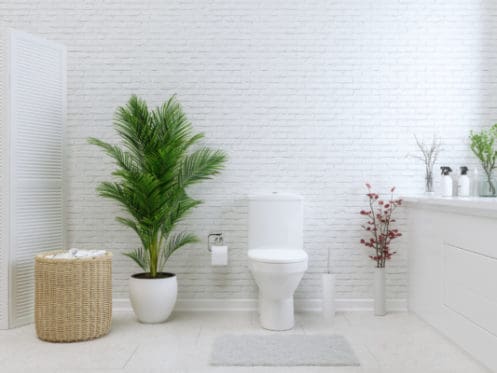To make a cat feel at home, you may have already made some modifications to your Metuchen, New Jersey home. From cat doors to scratching posts, these changes make life more enjoyable for animals and easier on their owners. However, additions such as flushable kitty litter can actually cause more problems than they solve. If you’ve been sending flushable litter down your commode, now is the time to stop.
What Is Flushable Cat Litter?
Marketed as a sustainable and more convenient alternative to traditional, scoopable kitty litter, flushable cat litter is comprised of natural, biodegradable ingredients. Made from materials like corn kernels, nut shells, wood shavings, and old newspapers, flushable litter is sold at grocery stores, pet stores and by many other major retailers.
This litter is marketed as being better for the natural environment. Moreover, if you keep your cat’s litter box in the bathroom, using flushable litter is probably a lot easier. Rather than scooping out clumps of used litter and putting them in a garbage bag, you can put your feline companion’s waste directly in the commode and then flush it down.
The Drawbacks of Flushable Cat Litter
The clumping action of scoopable cat litter is its greatest attribute. When cleaning urine out of litter boxes, most people prefer to pull out solid masses. Given that flushable litter isn’t made from heavy clays or from materials that become clay-like when dampened, you’ll be scooping out large amounts of loose, soiled litter and flushing these instead. Surprisingly, using this litter can be far messier overall, and it won’t provide the same measure of odor control. To get rid of all cat waste and all pungent odors, you’ll have to dispose of more flushable litter than you would if using standard, scoopable options that must be placed in the trash.
Is It Really Flushable?
Everything that’s used to make flushable litter is biodegradable. This means that it will break down over a very long period of time. However, it does not mean that it will break down into small pieces while it’s in your plumbing system. It’s never a good idea to flush wood and newspaper down your commode. Although the recycled newspapers and walnut husks that are found in flushable litters have been ground down into small pieces, adding them to water after they’ve been infused with animal waste will eventually cause them to accumulate and create clogs. If you have multiple cats or use flushable litter for a long period of time, a major backup is looming just around the corner.
Flushable litter can also get caught on minor obstructions in the pipes that lead to municipal sewer systems. It won’t break down in most septic systems, either. In fact, many companies that manufacture these products advise homeowners to make sure that their septic systems are compatible with flushable litter before using them at all.
Dry Waste
Sending solid, human waste down your toilet is one thing. Cat waste, however, usually sits in litter boxes for long stretches of time before it gets thrown out or flushed away. This waste is surrounded by absorbent materials that cause it to harden and petrify. Hard cat stools may take several flushes to go down. They may create blockages later on. This can mean more wear on your pipes, an increased risk of toilet clogs, and a noticeable rise in your home water bill.
Age Doesn’t Mean a Thing
Flushable kitty litter can be problematic in older plumbing systems that have already sustained a considerable amount of wear. If you have an older property, using these products can result in near-instant plumbing troubles. This is especially true if you have a historic home that still has clay pipes at its exterior that lead to the sewer main. These pipes are often encroached upon by tree roots. Accumulations of flushable kitty litter can get caught on these obstructions to further inhibit the flow of waste. Over time, this can lead to a whole-house backup.
Flushable kitty litter can be equally problematic in brand-new homes. Modern plumbing appliances are increasingly designed and manufactured to use less water. The average modern toilet uses about 1.6 gallons of water with every flush. With less water pressure and less fluid to help move this litter through the plumbing system, the risk of having a blockage or backup develop is always high.
If It’s Marketed as Flushable, Why Is It Unsafe?
If you use flushable wipes as part of your own self-care, you should know that although these products can be sent down commodes, this doesn’t mean that they should be. Long-term use of any flushable product that isn’t toilet paper or human waste will eventually cause problems. If you have a septic tank, flushable wipes and flushable kitty litter should never be used.
Although flushable litters are marketed as preventing messes and saving time, a single plumbing issue can instantly reverse any short-term benefits these products supply.
Biodegradable vs. Good for Your Toilets
Biodegradable is a word that’s widely misused by product marketers. It’s also widely misunderstood by consumers. Biodegradable means that something will gradually break down. This could sometimes take years, decades, or even centuries. In terms of how something performs when placed in water, it’s easy to see that ground walnut hulls, wood, and corn pulp won’t react the same way that toilet paper will. Grinding these materials up until they’re small in size or ultra-fine doesn’t make a huge difference in terms of plumbing system safety. Although “biodegradable” sounds good when used as a selling point, it’s incredibly misleading when applied to any “flushable” products that aren’t toilet paper.
Flushable Cat Litter and the Environment
If you’ve used it before, you’ve probably already discovered that flushable litter isn’t more convenient than conventional kitty litter. Using these dry, non-clumping products often entails a lot of sweeping and extra clean-up. Flushable litters also tend to be more odorous and more costly than their clumping alternatives.
However, if you feel like you’re doing something good for the environment, you might continue using flushable litters despite these drawbacks. What you may not know is that cat feces is actually dangerous to many species that will ultimately be exposed to it when flushable litters are used. Cat waste is infested with a parasite known as Toxoplasma gondii. According to the EPA, this parasite can be incredibly harmful to fish and marine mammal populations when introduced into local waterways. Thus, the best way to protect the natural environment when performing your cat clean-up is by depositing your pet’s waste into the trash.
How to Make Litter Clean-Up Easy Without Harming Your Plumbing
Environmentalists and plumbers agree. Kitty litter should be disposed of in the trash. If you’re committed to finding a way to make litter clean-up easy, look for a self-cleaning litter box. These relatively low-cost systems routinely scoop out solid masses and store them in bags for disposal. Apart from loading litter in and periodically replacing the system’s bags, there’s very little work on your end. Best of all, these litter boxes additionally provide effective odor and bacteria control.
At First Choice Plumbing, Heating & Air Conditioning, we’re committed to helping residents of Metuchen, New Jersey save money by avoiding common plumbing issues. In addition to helpful plumbing tips, we also provide plumbing installation, maintenance, and repair services. You can even turn to us for oil to gas conversions as well as heating and cooling services. Give us a call today.



